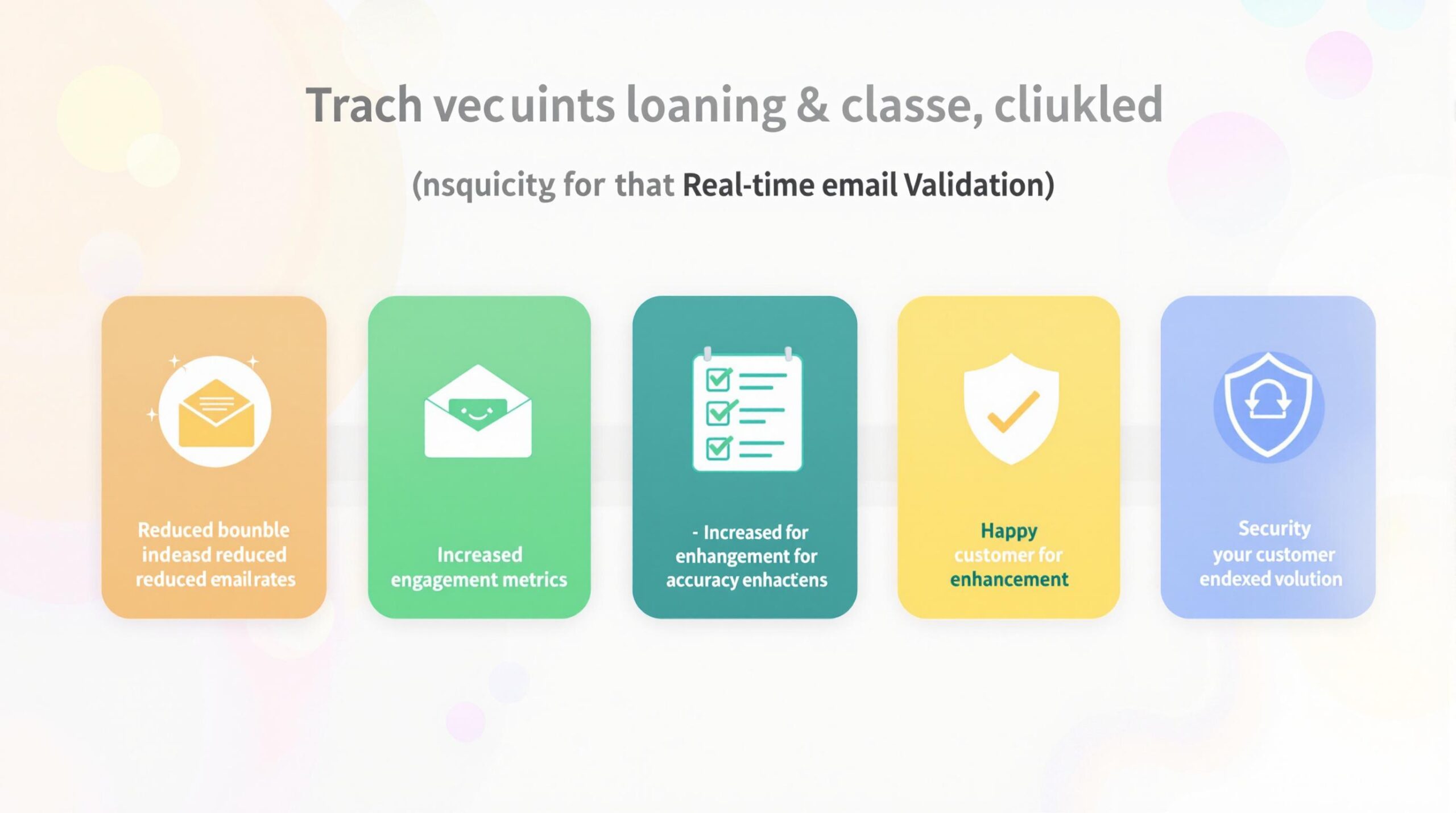Real-time email validation is a simple yet effective way to ensure accurate and valid email addresses at the point of entry. This process reduces bounce rates, protects sender reputation, and improves communication efficiency. By verifying emails instantly, businesses can prevent typos, block fake addresses, and ensure compliance with data regulations like GDPR and CCPA. Here’s a quick look at five key areas where this method makes a difference:
- E-commerce Checkouts: Fix typos, reduce cart abandonment by 3.2%, and prevent fraud.
- Lead Capture Forms: Boost follow-up email engagement by 30% and marketing ROI by 40%.
- SaaS Signups: Ensure onboarding emails reach users and block fraudulent accounts.
- Email List Management: Reduce bounce rates by 15% and minimize list cleanups.
- Support Ticket Systems: Cut ticket bounce rates by 15% and improve resolution times.
With deliverability rates exceeding 98% when implemented, real-time email validation is a must-have for businesses looking to streamline operations and improve customer interactions.
Real-time email validation: Verifying emails with API or Zapier

1. E-commerce Checkout
E-commerce checkouts lose $18 per invalid email due to failed communications. Adding real-time validation can reduce bounce rates by 2.7 percentage points and help recover abandoned carts [2].
Real-time validation during checkout plays several important roles:
- Fixing typos: Automatically corrects common mistakes like "gmial.com."
- Preventing fraud: Identifies and blocks disposable or fake email addresses, catching 30% more than manual checks.
- Improving user experience: Allows for instant error correction without disrupting the checkout process.
- Ensuring order updates: Makes sure customers receive shipping notifications and other key communications.
"Real-time validation at checkout protects both immediate revenue and long-term sender reputation – critical factors in e-commerce success."
To keep the checkout process smooth, validation should happen in under 300ms [4]. Adding visual cues, like green checkmarks for valid emails and clear error messages for invalid ones, can reduce cart abandonment rates by 3.2% [3].
This approach isn’t just for checkouts; it’s equally effective for lead capture forms. Even small errors in these forms can disrupt sales pipelines and hurt conversions.
2. Lead Capture Forms
Just like checkout forms, invalid emails account for 8.4% of lost potential leads [1]. That’s where real-time validation steps in, performing these key checks:
- Syntax verification: Ensures the email’s format and structure are correct.
- Domain validation: Confirms the email domain actually exists.
- Mailbox verification: Checks if the specific email address is active.
- Disposable email detection: Flags and blocks temporary or throwaway addresses.
Pairing these checks with instant visual feedback makes a big difference. For example, green checkmarks for valid emails or clear error messages for invalid entries help users fix mistakes quickly and easily. This approach works wonders in reducing frustration, a concept we’ll touch on again in the SaaS user onboarding section.
Here’s why it matters: Research shows companies using real-time validation in their lead forms saw a 30% boost in engagement for follow-up emails [3]. Early adopters also reported 85% inbox placement rates and a 40% increase in marketing ROI.
The key is finding the right balance between speed and accuracy. This ensures you maintain strong conversion rates while gathering reliable data.
sbb-itb-f42cab2
3. SaaS User Signup
For SaaS platforms, validating emails during the signup process is essential to prevent issues like deliverability problems caused by typos or invalid addresses. Real-time email verification serves three key purposes:
- Protecting sender reputation
- Ensuring onboarding emails reach users
- Blocking fraudulent signups
Using visual cues – like green checkmarks for valid emails and clear error messages – makes the process straightforward for users. This approach mirrors the familiar experience of e-commerce checkouts, keeping the signup flow smooth while ensuring accurate data.
"Real-time email validation is not just about reducing bounces; it’s about starting the customer relationship on the right foot. It ensures that your onboarding sequence reaches real users, setting the stage for better engagement and retention." – Sarah Joens, Customer Success Director at Intercom, Email Marketing Journal 2024.
For added security, SaaS platforms can integrate advanced validation tools to spot suspicious patterns that may signal bot activity [3]. This extra step helps protect against abuse while maintaining a seamless experience for genuine users.
Balancing user experience with security is a challenge seen across systems like support ticket platforms, where validation safeguards both customers and service teams.
4. Email List Management
Did you know that email lists shrink by 22.5% every year [1]? That’s why verifying email addresses in real time is so important for keeping your deliverability rates on track. In fact, businesses that use real-time validation report 5-15% better deliverability rates [6].
Real-time validation works by checking email addresses as they’re entered. This simple step doesn’t just reduce bounce rates – it also brings other benefits, such as:
- Lower average bounce rates (around 0.33%)
- 75% fewer list cleanups needed
- Stronger trust signals with ISPs
For the best results, pair real-time validation with a double opt-in process. This combo has been incredibly effective, with some companies achieving bounce rates as low as 0.33% [4].
This strategy also shines in customer service systems. By ensuring email accuracy, you can make sure support requests actually reach the right inbox.
5. Support Ticket Systems
In customer service, clear and accurate communication is crucial for maintaining trust. Support ticket systems play a key role in this, but 21% of tickets include invalid email addresses, causing delays in resolving issues [1]. Using real-time email validation can cut bounce rates by 15% and speed up resolution times [2].
Take Shopify as an example. By integrating Zendesk with real-time validation, they slashed their support ticket bounce rate from 8.7% to just 0.5% in 90 days. Emily Wong, their Customer Experience Director, shared:
"Implementing real-time email validation in our support ticket system was a game-changer. It not only improved our communication efficiency but also significantly enhanced our customer satisfaction scores."
On top of that, EmailOversight reports that businesses save up to $8 per customer interaction thanks to better efficiency and fewer follow-ups [2].
Here’s what real-time validation addresses in support ticket systems:
| Validation Targets | Support Impact |
|---|---|
| Syntax errors | Avoids formatting mistakes |
| Inactive mailboxes | Flags closed or outdated accounts |
| Role-based emails | Filters out generic addresses |
Conclusion
These five examples highlight how real-time email validation can make a noticeable difference at various customer interaction points. Whether it’s during checkout or in customer service, real-time validation plays a key role in improving processes and outcomes.
For instance, proper validation can boost email deliverability by 20-30% while reducing risks tied to poor list hygiene [5]. The healthcare industry offers a compelling example with Mount Sinai Hospital‘s patient communication system:
| Metric | Improvement |
|---|---|
| Patient Communication Accuracy | 45% increase |
| Administrative Time Saved | 28% reduction |
| Overall Communication Efficiency | 23% improvement |
Similarly, tools like Bouncebuster‘s API-first model make it easy to integrate validation into various systems. The goal is to ensure reliable validation while keeping operations smooth and effective.
As AI-driven spam filters become more advanced, businesses need to refine their validation strategies to keep up. This might involve:
- Integrating validation across different communication platforms
- Ensuring real-time responses
- Adopting industry-specific protocols
- Strengthening security measures
The results from these use cases underline the consistent benefits of real-time validation across industries. As customer demands shift, embedding validation into all communication channels will be crucial for maintaining both trust and efficiency.



